

Draft templates nov 2012 v2. National Resource & Referral Website for K-12 Education in the U.S. Three Lessons for Teachers from Grant Wiggins. By Jay McTighe The start of the new school year offers the perfect opportunity to reflect on the life and work of Grant Wiggins, an extraordinary educator who died unexpectedly at the end of the last school year (on May 26, 2015).

Although I am an only child, I considered Grant my brother as well as an intellectual partner and best friend. The student voice, Part 3. The most interesting work of the past year. One of the most interesting and revealing questions on our survey of middle and high school students involved their answer to the question: what was the most interesting work/task/project you had last year in school?

The results were fascinating and quite helpful for teachers, particularly if you ask yourself as you read: what do all these things have in common? In terms of patterns in the content of the answers, to me the most amazing result was that dozens of students identified fetal pig, shark, or rat dissection as their most interesting task of the past year. Another huge favorite was the chem. lab that involved making ice cream or Smores and analyzing why it worked. many students said “when they had to teach others” which is actually what got me into teaching as a 15-year-old in Algebra class!
Middle School Students Survey Responses: Most Interesting Work Last Year. A number of people have tweeted or emailed me to post survey responses from middle school students specifically.

So, here you go: a random sample from 1400+ answers – What was the MOST INTERESTING work (activity/project/test/lab etc.) you were asked to do in any class in the last few months? Describe what made it so interesting (so teachers can do more of it). Make a collage in English the project was interesting and probably one of the most fun I have had because it wasn’t really related to the book we read The Giver all we needed to do was cut out pictures or words that had to do with the theme of the story.making my me bag I got to teach others about meTo be honest I really like the catapult lab final in physics because of the hands on trial and error concept to it but I disliked the lack of materials to actually launch a projectile with.nothing we do in class is fun and interesting to me! I learn best when – Dg ubd templatev2 onepg. Dg ubd templatev2 onepg. Top 10 Lesson Plan Template Forms and Websites. Printable Lesson Templates, Forms, and Planning Guidance I like experimenting with new ways to approach lesson planning.

If you're looking for some fresh lesson templates, printable forms, and organizational support, these ten websites provide great tools to help you in your planning. The variety of templates range from simple fill-in-the-blank forms created by other teachers for a variety of lesson planning needs, to more sophisticated Web 2.0 lesson templates with interactive help, state and national standards alignment, collaboration, and more extensive planners. Listed in order below are my top ten favorite sites for fill-in-the-blank type templates and Web 2.0 interactive templates. The Madeline Hunter Direct Instruction Lesson Plan Model is the one I used when I started teaching. This version, from Dr. About 15 years ago, with the emphasis on standardized goals and learning objectives, a holistic lesson approach took shape: Understanding by Design.
"Feedback is information about how we are doing in our efforts to reach a goal"Grant Wiggins. How do you plan? On templates and instructional planning. How teachers plan – This is one of the more interesting ‘black boxes’ in education.
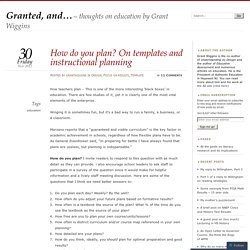
Grit, character and academic success: thoughtlessness, part 3. As readers may know, a new book is getting a lot of national press these days: How Children Succeed: Grit, Curiosity, and the Hidden Power of Character, by Paul Tough.
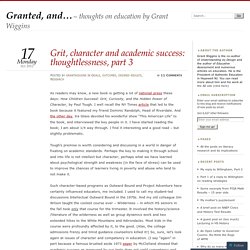
I well recall the NY Times article that led to the book because it featured my friend Dominic Randolph, Head of Riverdale. And the other day, Ira Glass devoted his wonderful show “This American Life” to the book, and interviewed the key people in it. Avoiding stupidification. Stupidification (n): 1.
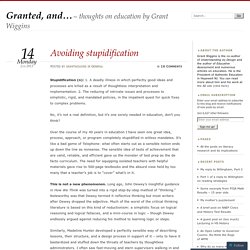
A deadly illness in which perfectly good ideas and processes are killed as a result of thoughtless interpretation and implementation. 2. Thinking about a lack of thinking. Lately I have been thinking a lot about thinking.
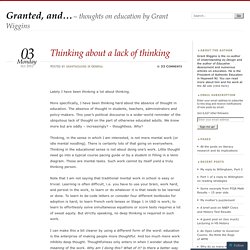
More specifically, I have been thinking hard about the absence of thought in education. The absence of thought in students, teachers, administrators and policy-makers. Thoughtlessness, part 2. What is thought-provoking is then not anything that we determine.

According to our assertion, what of itself gives us most to think about, what is most thought-provoking is this — that we are still not thinking. — Heidegger Thoughtlessness is thought-provoking. Bor-ing. Boredom: the sadly inevitable reality of most high schools and many middle and elementary schools.
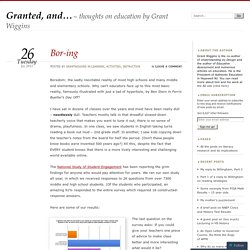
Why can’t educators face up to this most basic reality, famously illustrated with just a tad of hyperbole, by Ben Stein in Ferris Bueller’s Day Off? I have sat in dozens of classes over the years and most have been really dull – needlessly dull. Teachers mostly talk in that dreadful slowed-down teacherly voice that makes you want to tune it out; there is no sense of drama, playfulness. In one class, we saw students in English taking turns reading a book out loud – 2nd grade stuff. In another, I saw kids copying down the teacher’s notes from the board for half the period. The National Study of Student Engagement has been reporting the grim findings for anyone who would pay attention for years. Engagement and Personalization: Feedback Part 2. We know the relationship between feedback and achievement is strong.
What about the relationship between feedback, personalization and, hence, motivation? The recently-released Gallup poll on American education in which hundreds of thousands students and teachers were polled is quite revealing. The student voice – our survey, part 1. I am a big fan of student surveys. How can we achieve educational goals without the student’s perspective? We cannot. Decades ago, as a young teacher, I learned a great strategy from my colleague Duane. The student voice, Part 3. The most interesting work of the past year. The Student Voice, Part 5 – Common Practices That Don’t Work. One question from our student survey that generated very specific and (I think) helpful responses was: What is a very common teacher practice that occurs all the time in class but just does not work for you? The student voice – our survey, Part 4: “I learn best in class when…” IIn our continuing look at what works and doesn’t work for students, based on our 7300+ student survey reponses, we consider their answer to the prompt: I learn best in class when… There are few real surprises in the findings: they learn best when there is hands-on experience, lots of examples, discussion, order, visual aids.
But have a look at the patterns. More specifically, as you read these, ask yourself: Which of these form a consistent pattern of common-sense best practice? What works in education – Hattie’s list of the greatest effects and why it matters. [UPDATE February 2015: Over the past few years, numerous people have commented on my last paragraph as being an overstated and overheated conclusion, unwarranted by the data and of no help in advancing reform.
Fair enough: I have come to think that they are correct. So, a new concluding comment is attached, with the old concluding paragraph available for inspection. Begin with the End in Mind: Backward Design Your Course.
Ramblings of a Misguided Blonde. Essential Questions by Jay McTighe and Grant Wiggins Sometimes distinct areas of my life overlap. Why Students Don't Always Transfer What They Understand. Why Students Don’t Always Transfer What They Seem To Understand by Grant Wiggins, Authentic Education As a follow up on my series on reading, most recently yesterday’s post on reading comprehension with respect to the gradual release of responsibility model, let’s take a look at transfer.
Mod o on lesson plans excerpt. Lesson Planning and the Common Core: A Unit Based on TED.com. Lesson Planning and the Common Core: A Unit Based on TED.com.